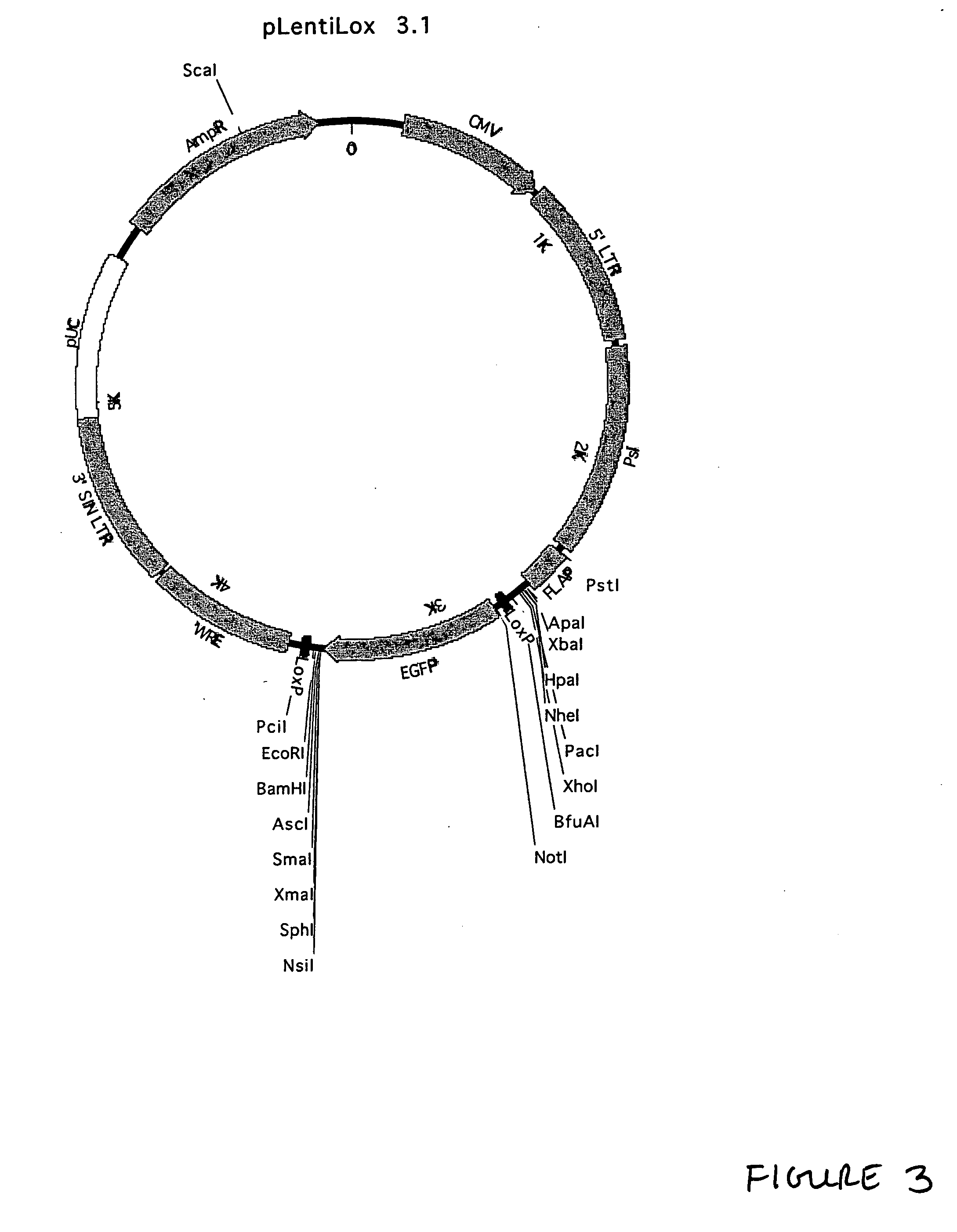Lentiviral vectors, related reagents, and methods of use thereof
a technology applied in the field of lentiviral vectors and related reagents, can solve the problems of limited efficacy of such in vivo applications, inability of vectors based on simple retroviruses to integrate into the genome of non-dividing (post-mitotic) cells, and the current optimality of lentiviral vectors
- Summary
- Abstract
- Description
- Claims
- Application Information
AI Technical Summary
Benefits of technology
Problems solved by technology
Method used
Image
Examples
example 1
Generation of pLentiLox Vectors
[0240] This example describes generation of the pLentiLox family of vectors. Unless otherwise indicated, standard molecular biology techniques were generally performed in accordance with guidance found in Current Protocols in Molecular Biology, edition as of 2001; or in Sambrook, Russell, and Sambrook, Molecular Cloning: A Laboratory Manual, 3rd ed., Cold Spring Harbor Laboratory Press, Cold Spring Harbor, 2001, or according to instructions provided by the manufacturer of the relevant reagents or kits. It is noted that a variety of different approaches to generating the constructs described below as well as alternative sources for the elements incorporated into the constructs may be employed. In particular, the sequence information provided herein enables one of ordinary skill in the art to chemically synthesize part or all of the constructs, thus offering considerable flexibility.
[0241] Characterization of pBFGW.
[0242] Generation of the pLentiLox v...
example 2
Generation of Lentiviral Vectors for RNAi
[0282] Modification of pLL2.0 for Use in RNAi
[0283] In order to drive expression of an RNAi-inducing stem-loop, we decided to incorporate a polIII promoter into a pLentilox series vector. In addition, we decided to incorporate a polII promoter to drive expressin of EGFP as a reporter. Because we were concerned that the placement of a strong polII promoter near a polIII promoter might interfere with poli function we chose to place the polII-EGFP cassette between LoxP sites. This would allow us to eliminate the polII promoter if we were failing to accumulate the stem-loop RNA.
[0284] We first inserted a cassette to drive expression of EGFP. A DNA fragment containing the CMV promoter upstream of the EGFP open reading frame was amplified from pEGFP-C1. The oligonucleotides were selected to engineer a 5′ NotI site and 3′ EcoRI site. The oligonucleotides used were:
[0285] 5′CMV / NotI: 5′-cggcggccgcgtggataaccgtattaccgccatg-3′ (SEQ ID NO: 19)
[0286]...
example 3
Specific Silencing of Genes in T Cells using a Lentiviral Vector
[0297] Materials and Methods
[0298] Cell Culture:
[0299] E10 and primary mouse splenocyte cultures were performed as previously described (11). 293T cells (human fibroblasts) were cultured as described (21). In vitro T-cell proliferation was performed on 200,000 activated T-cells cultured in the presence / absense of increasing doses of IL2 (0 to 100 ng / ml) and pulsed for 6 h with [3H]TdR to assay proliferation.
[0300] Oligonucleotide Design.
[0301] The following approach was used to design oligonucleotides suitable for cloning into pLL3.7 vectors to generate vectors capable of directing synthesis of shRNAs for gene silencing in this and the following examples. As described above, we have engineered a multiple cloning site immediately following the U6 promoter. An HpaI site leaves a blunt end prior to the −1 position in the promoter. The oligonucleotide design must incorporate a 5′ T in order to reconstitute the −1 nucle...
PUM
| Property | Measurement | Unit |
|---|---|---|
| Digital information | aaaaa | aaaaa |
| Digital information | aaaaa | aaaaa |
| Digital information | aaaaa | aaaaa |
Abstract
Description
Claims
Application Information
 Login to View More
Login to View More - R&D
- Intellectual Property
- Life Sciences
- Materials
- Tech Scout
- Unparalleled Data Quality
- Higher Quality Content
- 60% Fewer Hallucinations
Browse by: Latest US Patents, China's latest patents, Technical Efficacy Thesaurus, Application Domain, Technology Topic, Popular Technical Reports.
© 2025 PatSnap. All rights reserved.Legal|Privacy policy|Modern Slavery Act Transparency Statement|Sitemap|About US| Contact US: help@patsnap.com



